Projects Negotiation and Conflict Report: Queensland Health Payroll Program
VerifiedAdded on 2023/06/14
|8
|2466
|106
AI Summary
This report discusses the negotiation and conflict resolution strategies for the Queensland Health Payroll Program. It covers the characteristics of each project, the participants involved, recommended negotiation approaches, and preferred forms of procurement.
Contribute Materials
Your contribution can guide someone’s learning journey. Share your
documents today.
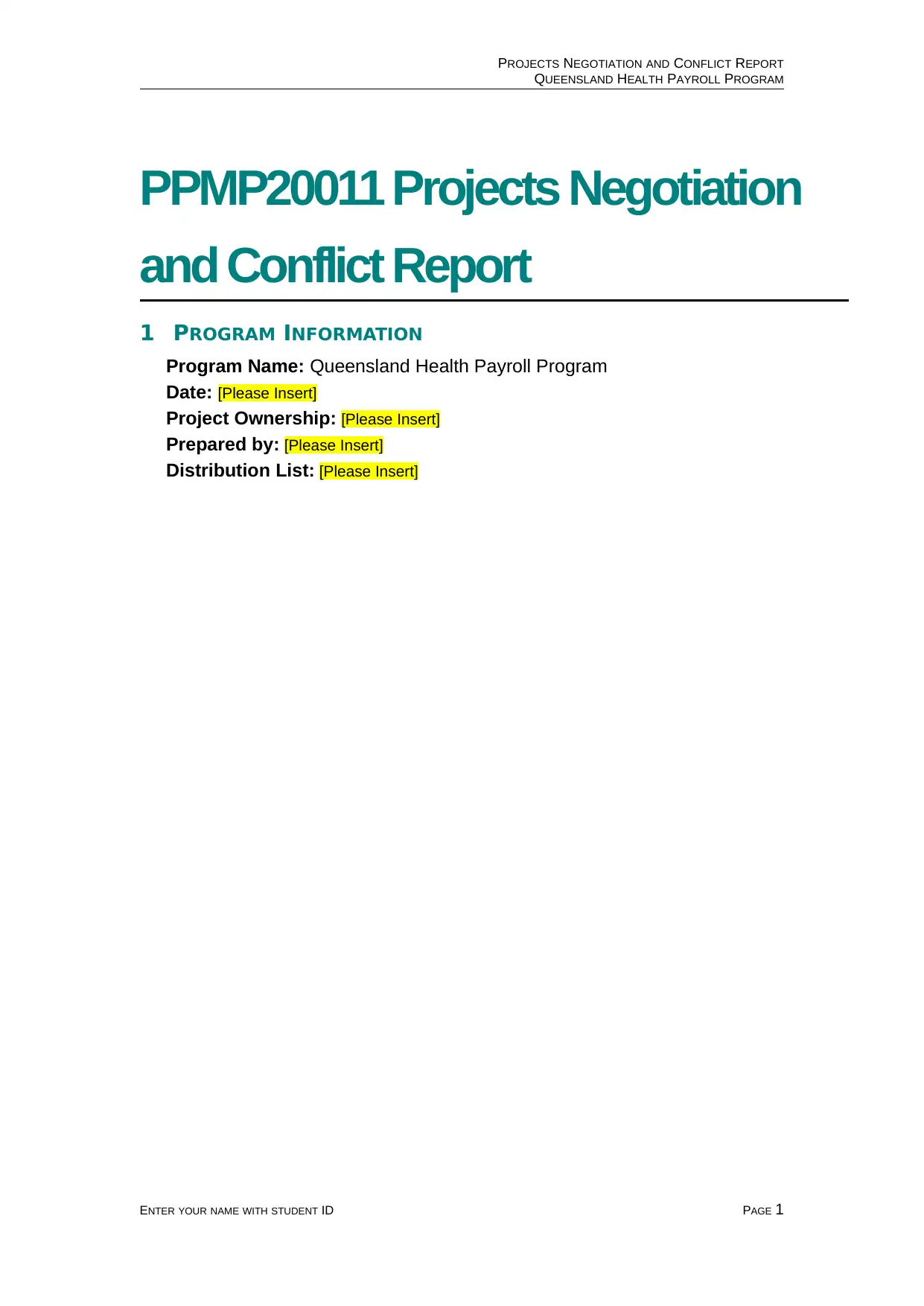
PROJECTS NEGOTIATION AND CONFLICT REPORT
QUEENSLAND HEALTH PAYROLL PROGRAM
PPMP20011 Projects Negotiation
and Conflict Report
1 PROGRAM INFORMATION
Program Name: Queensland Health Payroll Program
Date: [Please Insert]
Project Ownership: [Please Insert]
Prepared by: [Please Insert]
Distribution List: [Please Insert]
ENTER YOUR NAME WITH STUDENT ID PAGE 1
QUEENSLAND HEALTH PAYROLL PROGRAM
PPMP20011 Projects Negotiation
and Conflict Report
1 PROGRAM INFORMATION
Program Name: Queensland Health Payroll Program
Date: [Please Insert]
Project Ownership: [Please Insert]
Prepared by: [Please Insert]
Distribution List: [Please Insert]
ENTER YOUR NAME WITH STUDENT ID PAGE 1
Secure Best Marks with AI Grader
Need help grading? Try our AI Grader for instant feedback on your assignments.
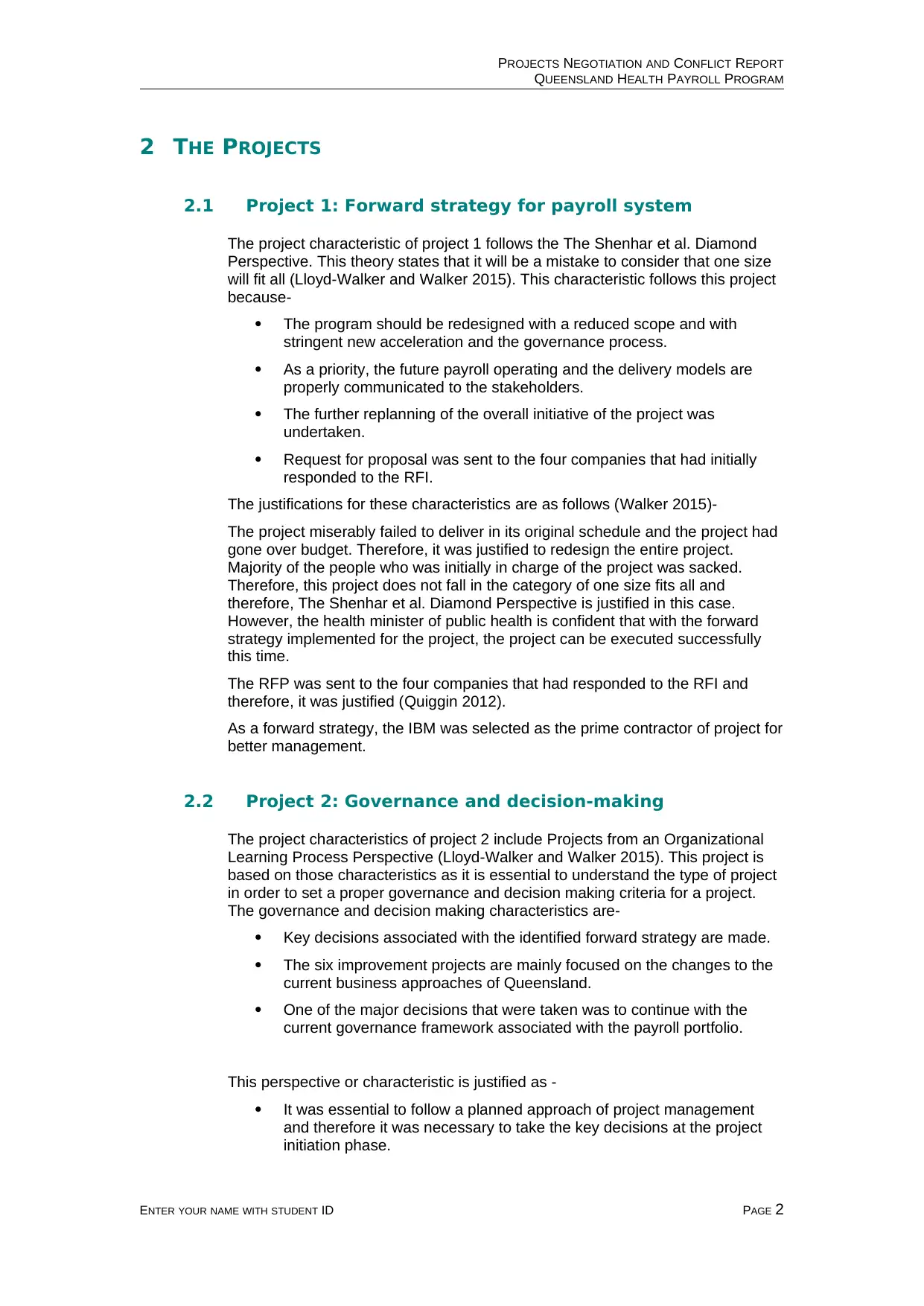
PROJECTS NEGOTIATION AND CONFLICT REPORT
QUEENSLAND HEALTH PAYROLL PROGRAM
2 THE PROJECTS
2.1 Project 1: Forward strategy for payroll system
The project characteristic of project 1 follows the The Shenhar et al. Diamond
Perspective. This theory states that it will be a mistake to consider that one size
will fit all (Lloyd-Walker and Walker 2015). This characteristic follows this project
because-
The program should be redesigned with a reduced scope and with
stringent new acceleration and the governance process.
As a priority, the future payroll operating and the delivery models are
properly communicated to the stakeholders.
The further replanning of the overall initiative of the project was
undertaken.
Request for proposal was sent to the four companies that had initially
responded to the RFI.
The justifications for these characteristics are as follows (Walker 2015)-
The project miserably failed to deliver in its original schedule and the project had
gone over budget. Therefore, it was justified to redesign the entire project.
Majority of the people who was initially in charge of the project was sacked.
Therefore, this project does not fall in the category of one size fits all and
therefore, The Shenhar et al. Diamond Perspective is justified in this case.
However, the health minister of public health is confident that with the forward
strategy implemented for the project, the project can be executed successfully
this time.
The RFP was sent to the four companies that had responded to the RFI and
therefore, it was justified (Quiggin 2012).
As a forward strategy, the IBM was selected as the prime contractor of project for
better management.
2.2 Project 2: Governance and decision-making
The project characteristics of project 2 include Projects from an Organizational
Learning Process Perspective (Lloyd-Walker and Walker 2015). This project is
based on those characteristics as it is essential to understand the type of project
in order to set a proper governance and decision making criteria for a project.
The governance and decision making characteristics are-
Key decisions associated with the identified forward strategy are made.
The six improvement projects are mainly focused on the changes to the
current business approaches of Queensland.
One of the major decisions that were taken was to continue with the
current governance framework associated with the payroll portfolio.
This perspective or characteristic is justified as -
It was essential to follow a planned approach of project management
and therefore it was necessary to take the key decisions at the project
initiation phase.
ENTER YOUR NAME WITH STUDENT ID PAGE 2
QUEENSLAND HEALTH PAYROLL PROGRAM
2 THE PROJECTS
2.1 Project 1: Forward strategy for payroll system
The project characteristic of project 1 follows the The Shenhar et al. Diamond
Perspective. This theory states that it will be a mistake to consider that one size
will fit all (Lloyd-Walker and Walker 2015). This characteristic follows this project
because-
The program should be redesigned with a reduced scope and with
stringent new acceleration and the governance process.
As a priority, the future payroll operating and the delivery models are
properly communicated to the stakeholders.
The further replanning of the overall initiative of the project was
undertaken.
Request for proposal was sent to the four companies that had initially
responded to the RFI.
The justifications for these characteristics are as follows (Walker 2015)-
The project miserably failed to deliver in its original schedule and the project had
gone over budget. Therefore, it was justified to redesign the entire project.
Majority of the people who was initially in charge of the project was sacked.
Therefore, this project does not fall in the category of one size fits all and
therefore, The Shenhar et al. Diamond Perspective is justified in this case.
However, the health minister of public health is confident that with the forward
strategy implemented for the project, the project can be executed successfully
this time.
The RFP was sent to the four companies that had responded to the RFI and
therefore, it was justified (Quiggin 2012).
As a forward strategy, the IBM was selected as the prime contractor of project for
better management.
2.2 Project 2: Governance and decision-making
The project characteristics of project 2 include Projects from an Organizational
Learning Process Perspective (Lloyd-Walker and Walker 2015). This project is
based on those characteristics as it is essential to understand the type of project
in order to set a proper governance and decision making criteria for a project.
The governance and decision making characteristics are-
Key decisions associated with the identified forward strategy are made.
The six improvement projects are mainly focused on the changes to the
current business approaches of Queensland.
One of the major decisions that were taken was to continue with the
current governance framework associated with the payroll portfolio.
This perspective or characteristic is justified as -
It was essential to follow a planned approach of project management
and therefore it was necessary to take the key decisions at the project
initiation phase.
ENTER YOUR NAME WITH STUDENT ID PAGE 2
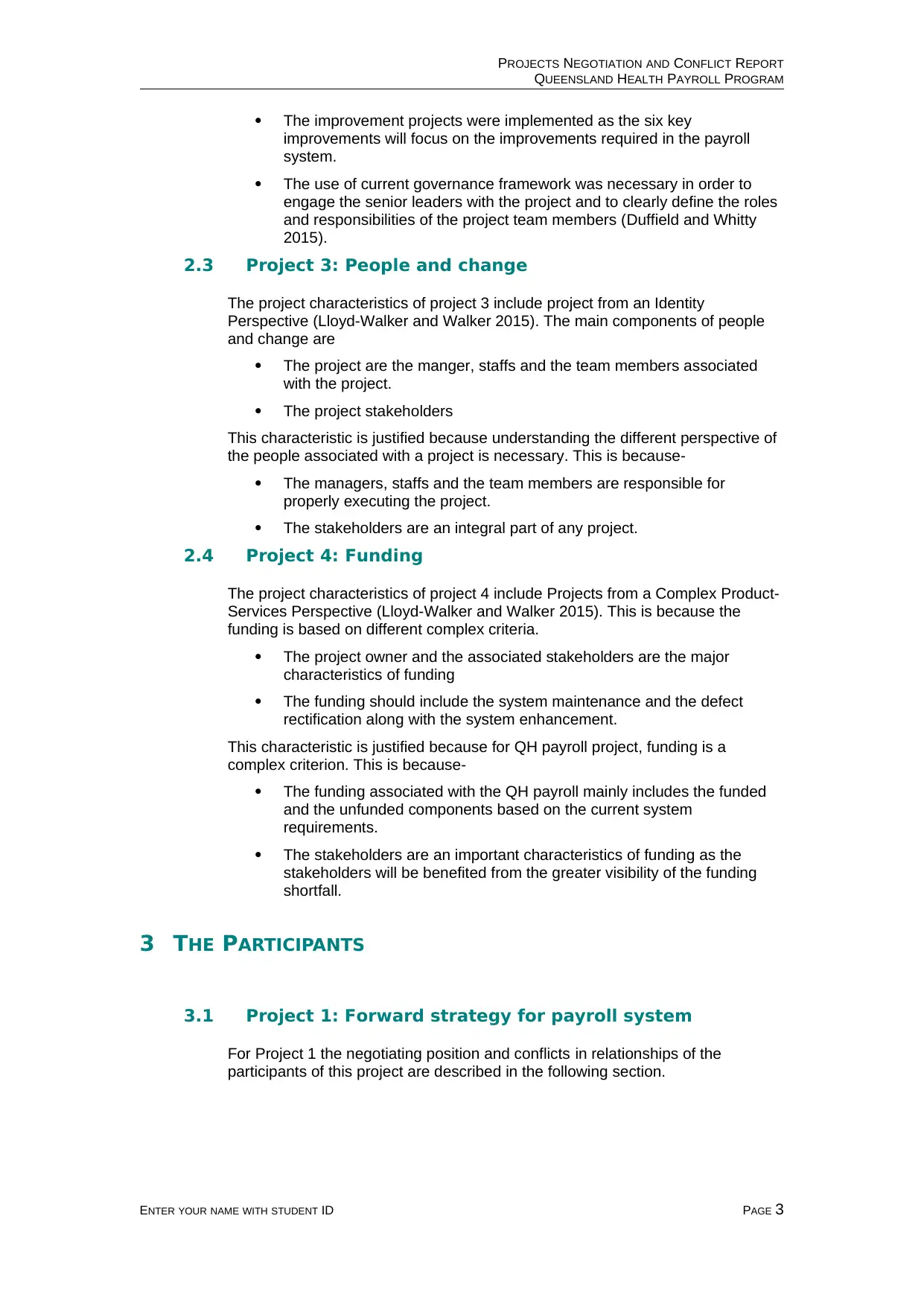
PROJECTS NEGOTIATION AND CONFLICT REPORT
QUEENSLAND HEALTH PAYROLL PROGRAM
The improvement projects were implemented as the six key
improvements will focus on the improvements required in the payroll
system.
The use of current governance framework was necessary in order to
engage the senior leaders with the project and to clearly define the roles
and responsibilities of the project team members (Duffield and Whitty
2015).
2.3 Project 3: People and change
The project characteristics of project 3 include project from an Identity
Perspective (Lloyd-Walker and Walker 2015). The main components of people
and change are
The project are the manger, staffs and the team members associated
with the project.
The project stakeholders
This characteristic is justified because understanding the different perspective of
the people associated with a project is necessary. This is because-
The managers, staffs and the team members are responsible for
properly executing the project.
The stakeholders are an integral part of any project.
2.4 Project 4: Funding
The project characteristics of project 4 include Projects from a Complex Product-
Services Perspective (Lloyd-Walker and Walker 2015). This is because the
funding is based on different complex criteria.
The project owner and the associated stakeholders are the major
characteristics of funding
The funding should include the system maintenance and the defect
rectification along with the system enhancement.
This characteristic is justified because for QH payroll project, funding is a
complex criterion. This is because-
The funding associated with the QH payroll mainly includes the funded
and the unfunded components based on the current system
requirements.
The stakeholders are an important characteristics of funding as the
stakeholders will be benefited from the greater visibility of the funding
shortfall.
3 THE PARTICIPANTS
3.1 Project 1: Forward strategy for payroll system
For Project 1 the negotiating position and conflicts in relationships of the
participants of this project are described in the following section.
ENTER YOUR NAME WITH STUDENT ID PAGE 3
QUEENSLAND HEALTH PAYROLL PROGRAM
The improvement projects were implemented as the six key
improvements will focus on the improvements required in the payroll
system.
The use of current governance framework was necessary in order to
engage the senior leaders with the project and to clearly define the roles
and responsibilities of the project team members (Duffield and Whitty
2015).
2.3 Project 3: People and change
The project characteristics of project 3 include project from an Identity
Perspective (Lloyd-Walker and Walker 2015). The main components of people
and change are
The project are the manger, staffs and the team members associated
with the project.
The project stakeholders
This characteristic is justified because understanding the different perspective of
the people associated with a project is necessary. This is because-
The managers, staffs and the team members are responsible for
properly executing the project.
The stakeholders are an integral part of any project.
2.4 Project 4: Funding
The project characteristics of project 4 include Projects from a Complex Product-
Services Perspective (Lloyd-Walker and Walker 2015). This is because the
funding is based on different complex criteria.
The project owner and the associated stakeholders are the major
characteristics of funding
The funding should include the system maintenance and the defect
rectification along with the system enhancement.
This characteristic is justified because for QH payroll project, funding is a
complex criterion. This is because-
The funding associated with the QH payroll mainly includes the funded
and the unfunded components based on the current system
requirements.
The stakeholders are an important characteristics of funding as the
stakeholders will be benefited from the greater visibility of the funding
shortfall.
3 THE PARTICIPANTS
3.1 Project 1: Forward strategy for payroll system
For Project 1 the negotiating position and conflicts in relationships of the
participants of this project are described in the following section.
ENTER YOUR NAME WITH STUDENT ID PAGE 3
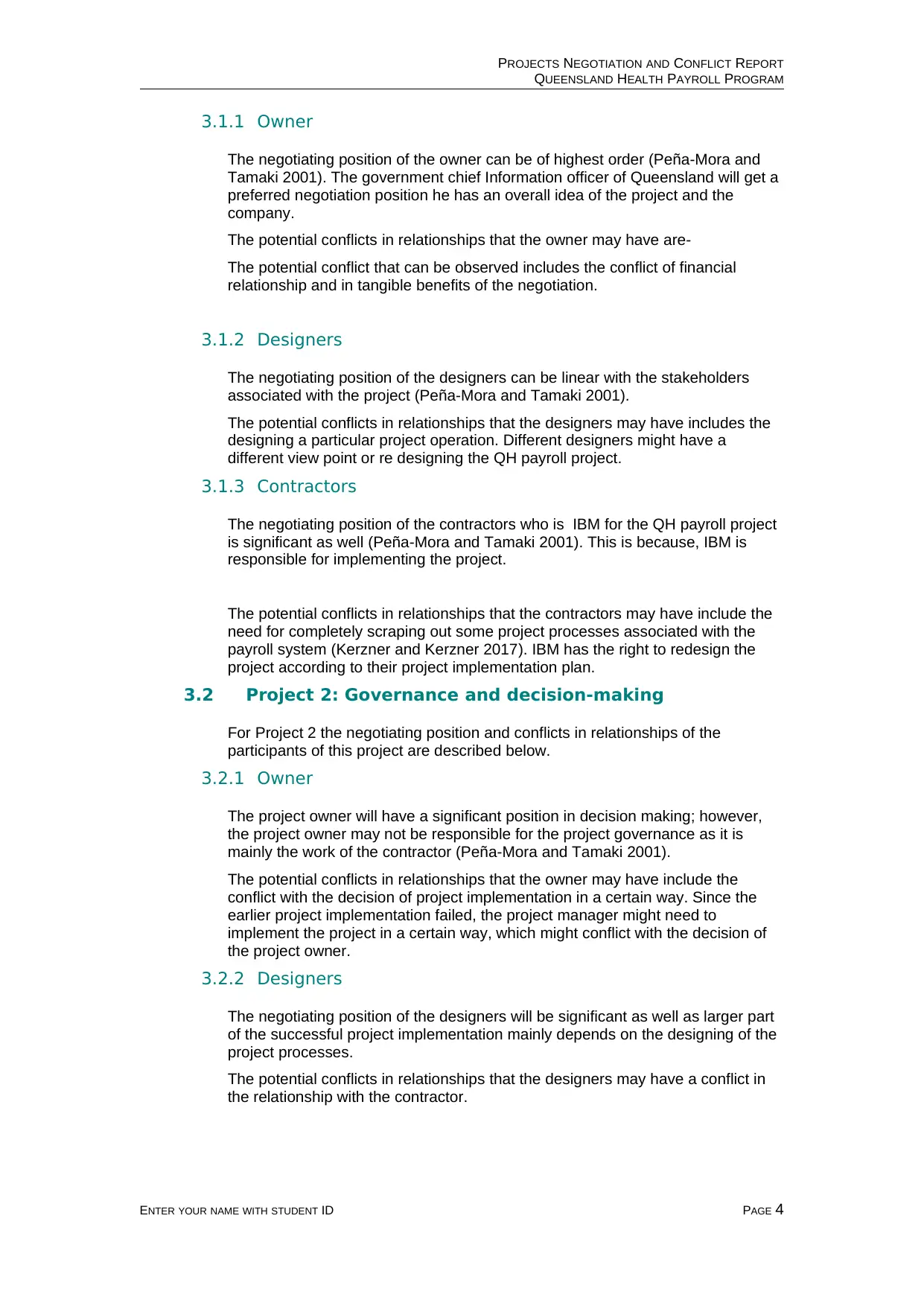
PROJECTS NEGOTIATION AND CONFLICT REPORT
QUEENSLAND HEALTH PAYROLL PROGRAM
3.1.1 Owner
The negotiating position of the owner can be of highest order (Peña-Mora and
Tamaki 2001). The government chief Information officer of Queensland will get a
preferred negotiation position he has an overall idea of the project and the
company.
The potential conflicts in relationships that the owner may have are-
The potential conflict that can be observed includes the conflict of financial
relationship and in tangible benefits of the negotiation.
3.1.2 Designers
The negotiating position of the designers can be linear with the stakeholders
associated with the project (Peña-Mora and Tamaki 2001).
The potential conflicts in relationships that the designers may have includes the
designing a particular project operation. Different designers might have a
different view point or re designing the QH payroll project.
3.1.3 Contractors
The negotiating position of the contractors who is IBM for the QH payroll project
is significant as well (Peña-Mora and Tamaki 2001). This is because, IBM is
responsible for implementing the project.
The potential conflicts in relationships that the contractors may have include the
need for completely scraping out some project processes associated with the
payroll system (Kerzner and Kerzner 2017). IBM has the right to redesign the
project according to their project implementation plan.
3.2 Project 2: Governance and decision-making
For Project 2 the negotiating position and conflicts in relationships of the
participants of this project are described below.
3.2.1 Owner
The project owner will have a significant position in decision making; however,
the project owner may not be responsible for the project governance as it is
mainly the work of the contractor (Peña-Mora and Tamaki 2001).
The potential conflicts in relationships that the owner may have include the
conflict with the decision of project implementation in a certain way. Since the
earlier project implementation failed, the project manager might need to
implement the project in a certain way, which might conflict with the decision of
the project owner.
3.2.2 Designers
The negotiating position of the designers will be significant as well as larger part
of the successful project implementation mainly depends on the designing of the
project processes.
The potential conflicts in relationships that the designers may have a conflict in
the relationship with the contractor.
ENTER YOUR NAME WITH STUDENT ID PAGE 4
QUEENSLAND HEALTH PAYROLL PROGRAM
3.1.1 Owner
The negotiating position of the owner can be of highest order (Peña-Mora and
Tamaki 2001). The government chief Information officer of Queensland will get a
preferred negotiation position he has an overall idea of the project and the
company.
The potential conflicts in relationships that the owner may have are-
The potential conflict that can be observed includes the conflict of financial
relationship and in tangible benefits of the negotiation.
3.1.2 Designers
The negotiating position of the designers can be linear with the stakeholders
associated with the project (Peña-Mora and Tamaki 2001).
The potential conflicts in relationships that the designers may have includes the
designing a particular project operation. Different designers might have a
different view point or re designing the QH payroll project.
3.1.3 Contractors
The negotiating position of the contractors who is IBM for the QH payroll project
is significant as well (Peña-Mora and Tamaki 2001). This is because, IBM is
responsible for implementing the project.
The potential conflicts in relationships that the contractors may have include the
need for completely scraping out some project processes associated with the
payroll system (Kerzner and Kerzner 2017). IBM has the right to redesign the
project according to their project implementation plan.
3.2 Project 2: Governance and decision-making
For Project 2 the negotiating position and conflicts in relationships of the
participants of this project are described below.
3.2.1 Owner
The project owner will have a significant position in decision making; however,
the project owner may not be responsible for the project governance as it is
mainly the work of the contractor (Peña-Mora and Tamaki 2001).
The potential conflicts in relationships that the owner may have include the
conflict with the decision of project implementation in a certain way. Since the
earlier project implementation failed, the project manager might need to
implement the project in a certain way, which might conflict with the decision of
the project owner.
3.2.2 Designers
The negotiating position of the designers will be significant as well as larger part
of the successful project implementation mainly depends on the designing of the
project processes.
The potential conflicts in relationships that the designers may have a conflict in
the relationship with the contractor.
ENTER YOUR NAME WITH STUDENT ID PAGE 4
Secure Best Marks with AI Grader
Need help grading? Try our AI Grader for instant feedback on your assignments.
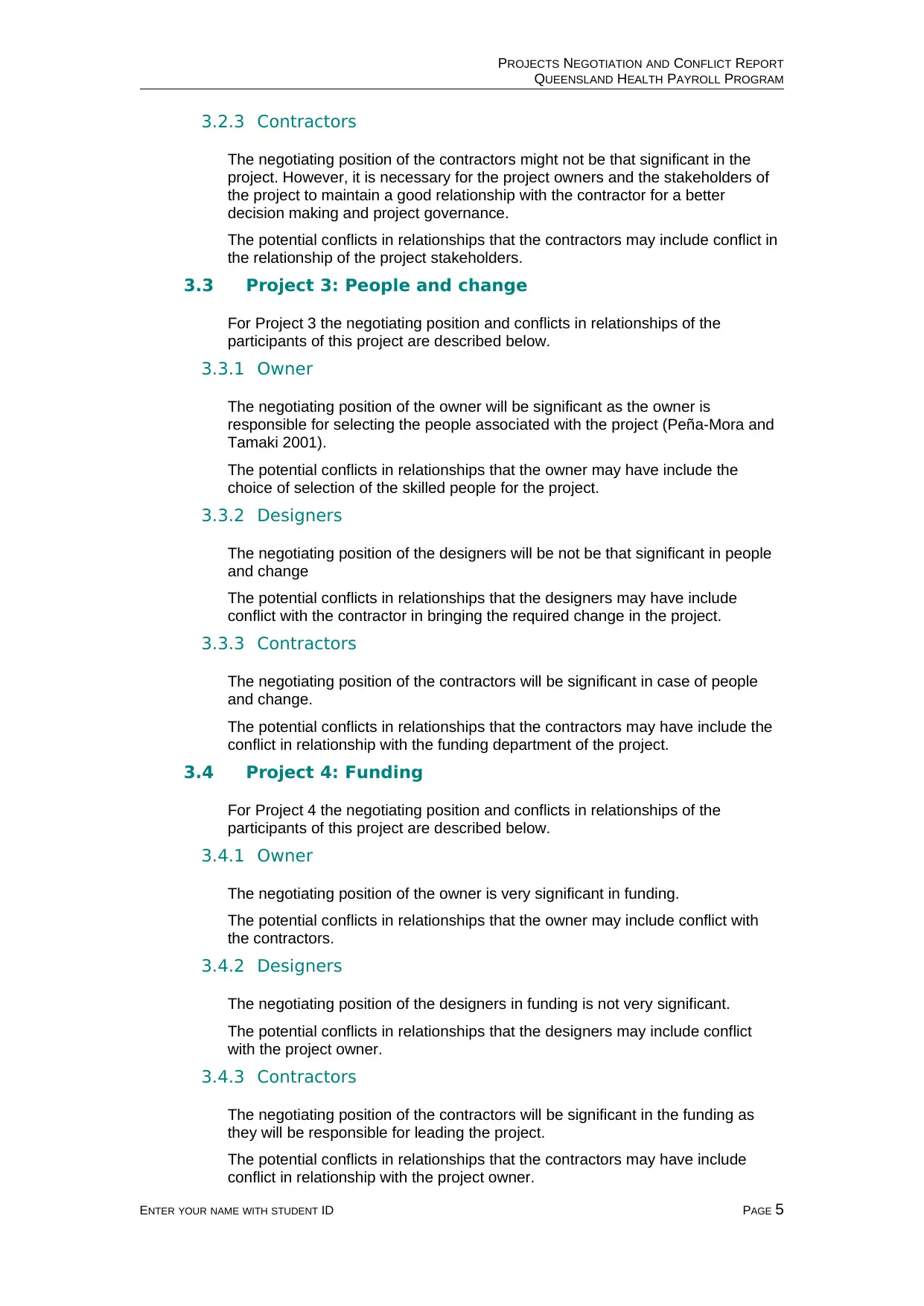
PROJECTS NEGOTIATION AND CONFLICT REPORT
QUEENSLAND HEALTH PAYROLL PROGRAM
3.2.3 Contractors
The negotiating position of the contractors might not be that significant in the
project. However, it is necessary for the project owners and the stakeholders of
the project to maintain a good relationship with the contractor for a better
decision making and project governance.
The potential conflicts in relationships that the contractors may include conflict in
the relationship of the project stakeholders.
3.3 Project 3: People and change
For Project 3 the negotiating position and conflicts in relationships of the
participants of this project are described below.
3.3.1 Owner
The negotiating position of the owner will be significant as the owner is
responsible for selecting the people associated with the project (Peña-Mora and
Tamaki 2001).
The potential conflicts in relationships that the owner may have include the
choice of selection of the skilled people for the project.
3.3.2 Designers
The negotiating position of the designers will be not be that significant in people
and change
The potential conflicts in relationships that the designers may have include
conflict with the contractor in bringing the required change in the project.
3.3.3 Contractors
The negotiating position of the contractors will be significant in case of people
and change.
The potential conflicts in relationships that the contractors may have include the
conflict in relationship with the funding department of the project.
3.4 Project 4: Funding
For Project 4 the negotiating position and conflicts in relationships of the
participants of this project are described below.
3.4.1 Owner
The negotiating position of the owner is very significant in funding.
The potential conflicts in relationships that the owner may include conflict with
the contractors.
3.4.2 Designers
The negotiating position of the designers in funding is not very significant.
The potential conflicts in relationships that the designers may include conflict
with the project owner.
3.4.3 Contractors
The negotiating position of the contractors will be significant in the funding as
they will be responsible for leading the project.
The potential conflicts in relationships that the contractors may have include
conflict in relationship with the project owner.
ENTER YOUR NAME WITH STUDENT ID PAGE 5
QUEENSLAND HEALTH PAYROLL PROGRAM
3.2.3 Contractors
The negotiating position of the contractors might not be that significant in the
project. However, it is necessary for the project owners and the stakeholders of
the project to maintain a good relationship with the contractor for a better
decision making and project governance.
The potential conflicts in relationships that the contractors may include conflict in
the relationship of the project stakeholders.
3.3 Project 3: People and change
For Project 3 the negotiating position and conflicts in relationships of the
participants of this project are described below.
3.3.1 Owner
The negotiating position of the owner will be significant as the owner is
responsible for selecting the people associated with the project (Peña-Mora and
Tamaki 2001).
The potential conflicts in relationships that the owner may have include the
choice of selection of the skilled people for the project.
3.3.2 Designers
The negotiating position of the designers will be not be that significant in people
and change
The potential conflicts in relationships that the designers may have include
conflict with the contractor in bringing the required change in the project.
3.3.3 Contractors
The negotiating position of the contractors will be significant in case of people
and change.
The potential conflicts in relationships that the contractors may have include the
conflict in relationship with the funding department of the project.
3.4 Project 4: Funding
For Project 4 the negotiating position and conflicts in relationships of the
participants of this project are described below.
3.4.1 Owner
The negotiating position of the owner is very significant in funding.
The potential conflicts in relationships that the owner may include conflict with
the contractors.
3.4.2 Designers
The negotiating position of the designers in funding is not very significant.
The potential conflicts in relationships that the designers may include conflict
with the project owner.
3.4.3 Contractors
The negotiating position of the contractors will be significant in the funding as
they will be responsible for leading the project.
The potential conflicts in relationships that the contractors may have include
conflict in relationship with the project owner.
ENTER YOUR NAME WITH STUDENT ID PAGE 5
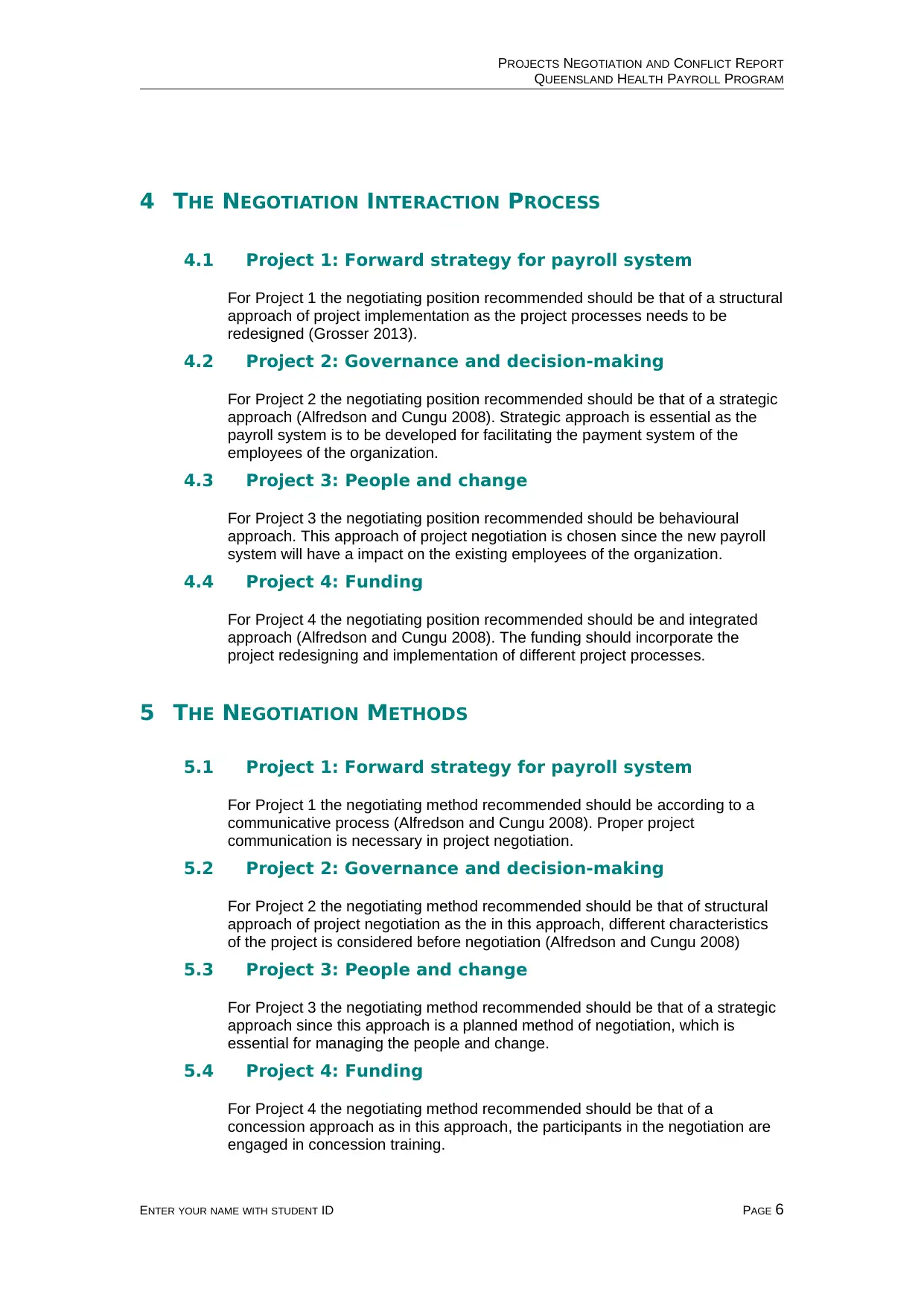
PROJECTS NEGOTIATION AND CONFLICT REPORT
QUEENSLAND HEALTH PAYROLL PROGRAM
4 THE NEGOTIATION INTERACTION PROCESS
4.1 Project 1: Forward strategy for payroll system
For Project 1 the negotiating position recommended should be that of a structural
approach of project implementation as the project processes needs to be
redesigned (Grosser 2013).
4.2 Project 2: Governance and decision-making
For Project 2 the negotiating position recommended should be that of a strategic
approach (Alfredson and Cungu 2008). Strategic approach is essential as the
payroll system is to be developed for facilitating the payment system of the
employees of the organization.
4.3 Project 3: People and change
For Project 3 the negotiating position recommended should be behavioural
approach. This approach of project negotiation is chosen since the new payroll
system will have a impact on the existing employees of the organization.
4.4 Project 4: Funding
For Project 4 the negotiating position recommended should be and integrated
approach (Alfredson and Cungu 2008). The funding should incorporate the
project redesigning and implementation of different project processes.
5 THE NEGOTIATION METHODS
5.1 Project 1: Forward strategy for payroll system
For Project 1 the negotiating method recommended should be according to a
communicative process (Alfredson and Cungu 2008). Proper project
communication is necessary in project negotiation.
5.2 Project 2: Governance and decision-making
For Project 2 the negotiating method recommended should be that of structural
approach of project negotiation as the in this approach, different characteristics
of the project is considered before negotiation (Alfredson and Cungu 2008)
5.3 Project 3: People and change
For Project 3 the negotiating method recommended should be that of a strategic
approach since this approach is a planned method of negotiation, which is
essential for managing the people and change.
5.4 Project 4: Funding
For Project 4 the negotiating method recommended should be that of a
concession approach as in this approach, the participants in the negotiation are
engaged in concession training.
ENTER YOUR NAME WITH STUDENT ID PAGE 6
QUEENSLAND HEALTH PAYROLL PROGRAM
4 THE NEGOTIATION INTERACTION PROCESS
4.1 Project 1: Forward strategy for payroll system
For Project 1 the negotiating position recommended should be that of a structural
approach of project implementation as the project processes needs to be
redesigned (Grosser 2013).
4.2 Project 2: Governance and decision-making
For Project 2 the negotiating position recommended should be that of a strategic
approach (Alfredson and Cungu 2008). Strategic approach is essential as the
payroll system is to be developed for facilitating the payment system of the
employees of the organization.
4.3 Project 3: People and change
For Project 3 the negotiating position recommended should be behavioural
approach. This approach of project negotiation is chosen since the new payroll
system will have a impact on the existing employees of the organization.
4.4 Project 4: Funding
For Project 4 the negotiating position recommended should be and integrated
approach (Alfredson and Cungu 2008). The funding should incorporate the
project redesigning and implementation of different project processes.
5 THE NEGOTIATION METHODS
5.1 Project 1: Forward strategy for payroll system
For Project 1 the negotiating method recommended should be according to a
communicative process (Alfredson and Cungu 2008). Proper project
communication is necessary in project negotiation.
5.2 Project 2: Governance and decision-making
For Project 2 the negotiating method recommended should be that of structural
approach of project negotiation as the in this approach, different characteristics
of the project is considered before negotiation (Alfredson and Cungu 2008)
5.3 Project 3: People and change
For Project 3 the negotiating method recommended should be that of a strategic
approach since this approach is a planned method of negotiation, which is
essential for managing the people and change.
5.4 Project 4: Funding
For Project 4 the negotiating method recommended should be that of a
concession approach as in this approach, the participants in the negotiation are
engaged in concession training.
ENTER YOUR NAME WITH STUDENT ID PAGE 6
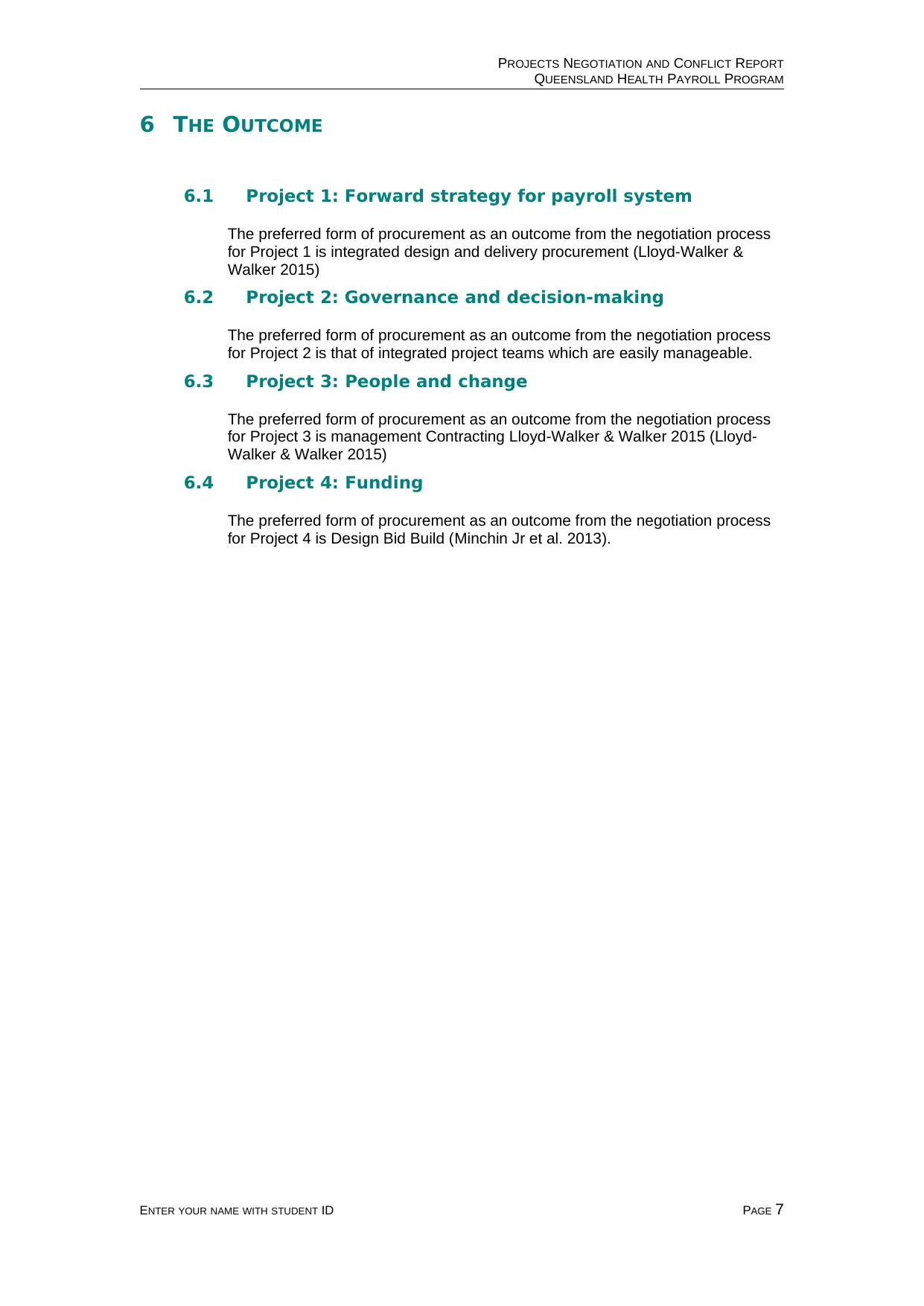
PROJECTS NEGOTIATION AND CONFLICT REPORT
QUEENSLAND HEALTH PAYROLL PROGRAM
6 THE OUTCOME
6.1 Project 1: Forward strategy for payroll system
The preferred form of procurement as an outcome from the negotiation process
for Project 1 is integrated design and delivery procurement (Lloyd-Walker &
Walker 2015)
6.2 Project 2: Governance and decision-making
The preferred form of procurement as an outcome from the negotiation process
for Project 2 is that of integrated project teams which are easily manageable.
6.3 Project 3: People and change
The preferred form of procurement as an outcome from the negotiation process
for Project 3 is management Contracting Lloyd-Walker & Walker 2015 (Lloyd-
Walker & Walker 2015)
6.4 Project 4: Funding
The preferred form of procurement as an outcome from the negotiation process
for Project 4 is Design Bid Build (Minchin Jr et al. 2013).
ENTER YOUR NAME WITH STUDENT ID PAGE 7
QUEENSLAND HEALTH PAYROLL PROGRAM
6 THE OUTCOME
6.1 Project 1: Forward strategy for payroll system
The preferred form of procurement as an outcome from the negotiation process
for Project 1 is integrated design and delivery procurement (Lloyd-Walker &
Walker 2015)
6.2 Project 2: Governance and decision-making
The preferred form of procurement as an outcome from the negotiation process
for Project 2 is that of integrated project teams which are easily manageable.
6.3 Project 3: People and change
The preferred form of procurement as an outcome from the negotiation process
for Project 3 is management Contracting Lloyd-Walker & Walker 2015 (Lloyd-
Walker & Walker 2015)
6.4 Project 4: Funding
The preferred form of procurement as an outcome from the negotiation process
for Project 4 is Design Bid Build (Minchin Jr et al. 2013).
ENTER YOUR NAME WITH STUDENT ID PAGE 7
Paraphrase This Document
Need a fresh take? Get an instant paraphrase of this document with our AI Paraphraser

PROJECTS NEGOTIATION AND CONFLICT REPORT
QUEENSLAND HEALTH PAYROLL PROGRAM
7 REFERENCES
Alfredson, T. and Cungu, A., 2008. Negotiation theory and practice: A review of
the literature. Esaypol on line resource materials for policymaking.
Duffield, S. and Whitty, S.J., 2015. Developing a systemic lessons learned
knowledge model for organisational learning through projects. International
journal of project management, 33(2), pp.311-324.
Grosser, M., 2013. Legal lessons from the Queensland health payroll
report. Government News, 33(5), p.20.
Kerzner, H. and Kerzner, H.R., 2017. Project management: a systems approach
to planning, scheduling, and controlling. John Wiley & Sons.
Lloyd-Walker, B. and Walker, D., 2015, April. Collaborative project procurement
arrangements. Project Management Institute.
Minchin Jr, R.E., Li, X., Issa, R.R. and Vargas, G.G., 2013. Comparison of cost
and time performance of design-build and design-bid-build delivery systems in
Florida. Journal of Construction Engineering and Management, 139(10),
p.04013007.
Peña-Mora, F. and Tamaki, T., 2001. Effect of delivery systems on collaborative
negotiations for large-scale infrastructure projects. Journal of Management in
Engineering, 17(2), pp.105-121.
Quiggin, J., 2012. The Queensland commission of audit interim report-June
2012: A critical review. Public Policy, 7(2), p.125.
Walker, A., 2015. Project management in construction. John Wiley & Sons.
ENTER YOUR NAME WITH STUDENT ID PAGE 8
QUEENSLAND HEALTH PAYROLL PROGRAM
7 REFERENCES
Alfredson, T. and Cungu, A., 2008. Negotiation theory and practice: A review of
the literature. Esaypol on line resource materials for policymaking.
Duffield, S. and Whitty, S.J., 2015. Developing a systemic lessons learned
knowledge model for organisational learning through projects. International
journal of project management, 33(2), pp.311-324.
Grosser, M., 2013. Legal lessons from the Queensland health payroll
report. Government News, 33(5), p.20.
Kerzner, H. and Kerzner, H.R., 2017. Project management: a systems approach
to planning, scheduling, and controlling. John Wiley & Sons.
Lloyd-Walker, B. and Walker, D., 2015, April. Collaborative project procurement
arrangements. Project Management Institute.
Minchin Jr, R.E., Li, X., Issa, R.R. and Vargas, G.G., 2013. Comparison of cost
and time performance of design-build and design-bid-build delivery systems in
Florida. Journal of Construction Engineering and Management, 139(10),
p.04013007.
Peña-Mora, F. and Tamaki, T., 2001. Effect of delivery systems on collaborative
negotiations for large-scale infrastructure projects. Journal of Management in
Engineering, 17(2), pp.105-121.
Quiggin, J., 2012. The Queensland commission of audit interim report-June
2012: A critical review. Public Policy, 7(2), p.125.
Walker, A., 2015. Project management in construction. John Wiley & Sons.
ENTER YOUR NAME WITH STUDENT ID PAGE 8
1 out of 8
Related Documents
Your All-in-One AI-Powered Toolkit for Academic Success.
+13062052269
info@desklib.com
Available 24*7 on WhatsApp / Email
![[object Object]](/_next/static/media/star-bottom.7253800d.svg)
Unlock your academic potential
© 2024 | Zucol Services PVT LTD | All rights reserved.



